Lowell Week in Review: June 18, 2018
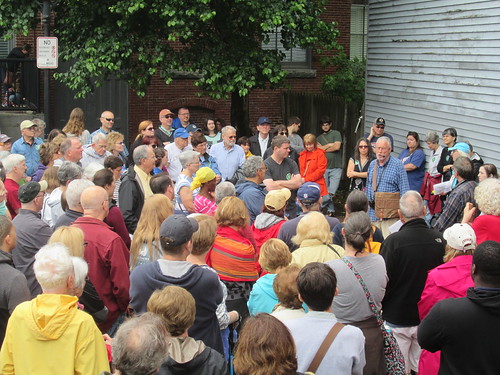
Bob Forrant describing the Abolitionist Movement in Lowell alongside Pawtucket Canal at Central Street to the 226 people on yesterday’s Lowell Walk
The City as a Classroom
The City as a Classroom. That’s what Pat Mogan used to say. In the late 1990s, I interviewed Dr. Mogan several times to prepare for an LTC program which gave me some first-hand exposure into how he thought about Lowell. Mogan was a lifelong educator, but he was convinced that true learning occurred not inside the classroom, but in the world around you. In that regard, he saw Lowell, the city, as the perfect classroom. The city’s rich immigrant history allowed people to learn from each other while the city’s central role in the Industrial Revolution in America had much to teach about industrialization and then deindustrialization.
I consider Paul Marion, author of Mill Power: The Origin and Impact of Lowell National Historical Park, the local expert on Moganesque matters. Here’s some of what Paul wrote about Pat in Mill Power:
. . . Mogan most clearly and consistently described what the city could be and expressed a rationale for mobilization. Mogan and his robust band reconceived Lowell as a city-scale lifelong learning laboratory. The grassroots effort embodied the rock-ribbed American value of progress through education.
. . . Mogan added [to his story about Lowell’s past] a balancing future side that suggested how Lowell could reclaim its special place in American history: the city would be reshaped into a museum without walls, a living exhibit of the process and consequences of the American Industrial Revolution—a place so compelling visually and expressively that visitors would fill city streets, scholars would come to write books, and chief executive officers would establish businesses in an inspiring, purposeful renaissance city.
. . . [Mogan] had connected the prevailing negative community mindset in Lowell with lagging educational achievement and poor self-esteem among school children.
. . . [Mogan’s] answer for repairing the breach between “Who am I?” and “Where do I come from?” was to focus his thinking on the fact that Lowell was a place to be proud of because of the role it played in the formation of America.”
And here’s Pat Mogan in his own words, from p. 23 of Mill Power:
“There’s not a lot of learning in schools. Some people confuse knowing something with understanding something. You’ll never understand anything unless you apply it in some circumstance and find out if it’s working or not . . . . Your learning is occurring with some kind of dialogue that is not happening in the schools but is happening outside the schools. The school is a small factor, maybe a 20 percent factor in learning, and your home, neighbors, and peers combine for an eighty percent factor in learning.”
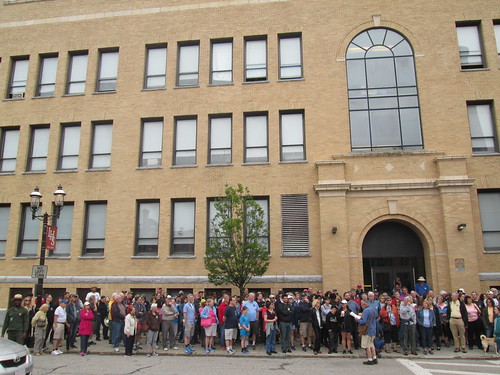
Lowell Walks at Lowell High School, the first integrated high school in America
The Classroom in Use
Pat Mogan’s vision of the city as a classroom was very much in evidence downtown yesterday morning as UMass Lowell historian Bob Forrant and history student Emily Yunes led 226 people on a Lowell Walk on abolitionism and the Underground Railroad in Lowell. Stopping at the Mill Girls statue, St. Anne’s Church, Lowell High School, the Mill Agent’s House, and alongside the Pawtucket Canal, we learned how those places were involved in the Underground Railroad, the Abolitionist Movement, and making Lowell the 19th century equivalent of a Sanctuary City in its opposition to the Fugitive Slave Act.
We had a similar experience last week when I led 150 people on a walk along the Western Canal. There’s a paved and lighted walkway that runs along that canal from near the intersection of Broadway and Fletcher (alongside the American Textile History Museum) to the Merrimack River behind the Tsongas Arena. It is a fantastic water-side amenity, but hardly anyone knows of its existence and even fewer people use it.
Our experience with Lowell Walks and other events of that type prove again and again that people will come to downtown Lowell for recreation, culture, entertainment and education. And when the walk is over, many grab lunch in a downtown restaurant, or shop in a local store.
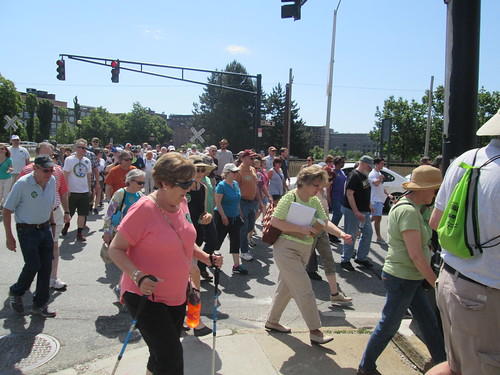
Lowell Walks crossing Dutton at Broadway on June 10, 2017
Just Add People
I’ve long thought that the biggest problem with downtown Lowell is a lack of people. Go downtown on a weekend afternoon and unless there’s a festival or a convention at the arena, there is no one there. That’s sad considering that since the creation of Lowell National Park back in the late 1970s, the government at all levels, community groups, and private investors have spent more than a billion dollars building and renovating buildings, walkways, waterways, streets and other physical structures. There is much to do, much to see, and much to experience. But few take advantage of all of these things and that contributes to the scarcity of people downtown.
That’s one of the reasons I’m befuddled that so many think taking the nearly 4000 students and staff at Lowell High from the center of downtown and plopping them on the outskirts of the city is a good thing. Yes, the students are in class throughout the day and the extent to which they benefit businesses is something that can be debated (although I believe they benefit businesses far more than they are credited with doing). But at least they are downtown. Without them, the sidewalks are largely deserted. What’s the plan for replacing them, or more importantly, why hasn’t there been greater effort made to bring people of all ages into downtown on a regular basis?
True, we have festivals that are wonderful. They should be supported and expanded. Festivals are part of the solution but they are not the exclusive solution. There have to be more people out and walking around downtown on a daily basis, but especially on weekends year-round and on summertime evenings.
Maybe a decade ago, the Urban Land Institute studied Lowell and concluded that the number of downtown residents needed to at least double to achieve a population level that would support a vibrant retail sector. So if Lowell High School does move out of downtown, housing would be the best thing to take its place. Advocates for the LHS at Cawley option assure us repeatedly that developers will be tripping over themselves with project proposals for the current LHS site. For all of our sakes, I hope they know what they are talking about.
Urban Residences Done Right
The type of people who choose to live downtown (as opposed to those who are forced by circumstances to live there) want the city to be more walkable, friendlier to pedestrians, with more and safer access to waterways and green spaces. It’s possible to do all of those things with present and future downtown residential developments, but only if city officials are truly committed to implementing these things.
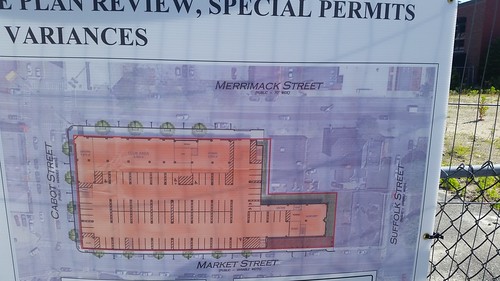
Proposed private dormitory in the Acre
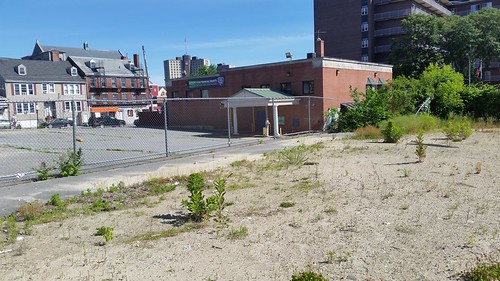
Site of proposed private dormitory, from Market St looking towards Suffolk and rear of former JDCU main branch.
A test case for this commitment will come before the planning board this Monday night when it takes up a proposal to build a 400-bed private dormitory at Merrimack and Cabot streets on the former Jeanne d’Arc Credit Union site. New Urbanist thinking says traditional urban building requirements of one or more parking spaces per unit are outdated and suppress good developments. This dormitory project proposes 96 parking spaces for 400 beds, so the developer does seek to take advantage of that part of New Urbanist philosophy. But that same philosophy also says that you must line the first floor of such a structure with retail establishments. Having doorways and store windows is what makes a place walkable which in turn attracts people who don’t have cars. But the dormitory project offers no retail – just walls lining the sidewalks with no spaces open to the public. This absence of retail is contrary to making the neighborhood more walkable and it also deprives the people who already live in the area of the type of open-to-the-public amenities that might make fewer parking spaces a tolerable tradeoff.
Development by Desperation
Whichever site is chosen for the new high school, the project will come at enormous cost to the city. The pressure to bring in new property-tax producing projects will be immense. It will create pressure on the city and its boards to relax regulations and guidelines like those that would require first floor retail or compliance with historic board standards. The temptation to grab short-term gain at the expense of long-term harm has always been strong (how many times has the abolition of the historic board been advocated any time a favored developer complains?) but it will be stronger than ever once $150 million in new indebtedness for the high school project is added to the city’s books.
It is also a time when a number of important properties will soon be vacant. Besides the high school buildings (if the new one moves to Cawley), there are three courthouses – Superior Court on Gorham Street, District Court on Hurd Street, and the privately-owned Juvenile Court on Appleton Street – that will all be vacant by 2020 when the new Judicial Center opens. Then you have the slow-to-get-started Hamilton Canal District and then all the vacancies in existing downtown building. Add all of that up and you have an enormous amount of space ready for development. Done right, it could transform the city in a positive way. Done in a short-sighted way that shuns good urban planning practices in favor of quick spurts of tax revenue, it could condemn the city to decades of mediocrity.
As someone recently wrote in a comment to another post on this site, “. . . Lowell’s urban renaissance was built on a certain set of values, and those values have proven themselves. We can trust in those principles to guide our decision. . . .”
The person making this comment argued that applying these principles to the high school decision should result in the school staying downtown. But setting aside the high school decision, the statements I’ve quoted apply to every potential development in the city. These sentiments should be inscribed on the walls of the Council Chamber and recited at the start of each meeting. The development principles that have allowed Lowell to separate itself from Lawrence and Brockton and other Gateway Cities are sound and proven. Just because they are hard or expensive to implement doesn’t mean they should be cast aside. We know what works. The question is, do we have the self-discipline and good judgment to stay on that path.
Serious mistake moving LHS from downtown. Four generations of my family graduated from it, and it’s downtown location provided easy access to an excellent education. LHS and Lucy Larcome Park should remain together, side by side, for all time. It’s an important part of the history and culture of our fair city!
Thank you for yet another excellent and truth filled blog Dick. Lowell teems with vitality during events (and for an hour after school!) and then reverts to dark and empty each time. We hear so much about the untapped potential in this stout city full of spirit and good intentions. We have shared hope and watched from Cobblestones single pane windows, progress creep ever forward. Where will the visionary come from who can lead us to the next level? Who can deliver on the premise of a downtown where festivals, concerts, theater and sports events simply compliment already vibrant city streets on a daily basis?!
Rodney Elliot and Corey Belanger are quite excited about all the wonderful development that will surely occur if they leave a huge, vacant Lowell High site in the middle of downtown. I haven’t seen that much confidence since the city destroyed Little Canada. How long did those “development sites” sit there as surface parking and vacant lots? 30 years? 40?
Anyway, the decision to move LHS out of downtown would produce the serious harm of making it impossible for the residents of Lowell’s central neighborhoods. Given the demographic profile of those neighborhoods vs. the city as a whole, that adds up to a significant disparate impact upon Lowell’s communities of color. The Council and the City Solicitor ought to think long and hard about what happens next if they vote for the Cawley site.